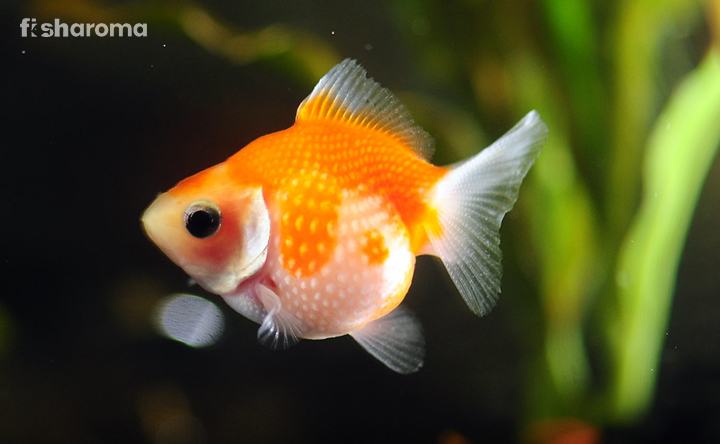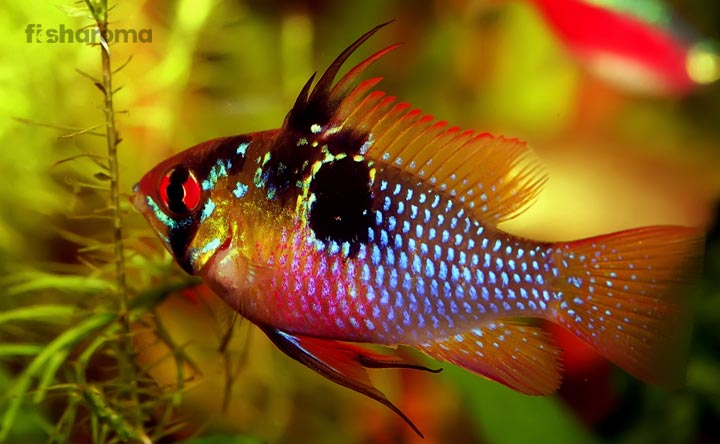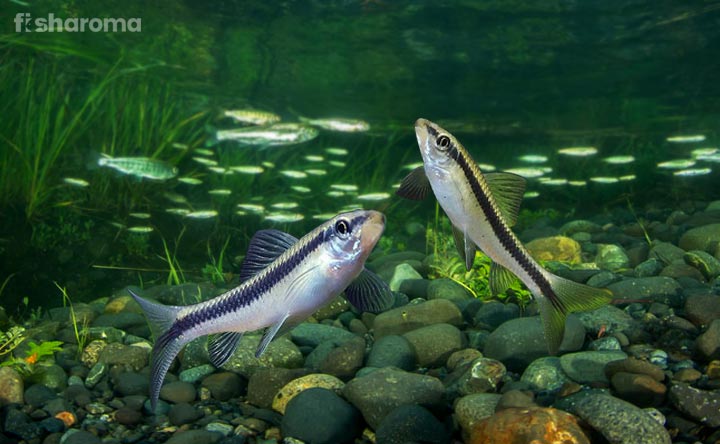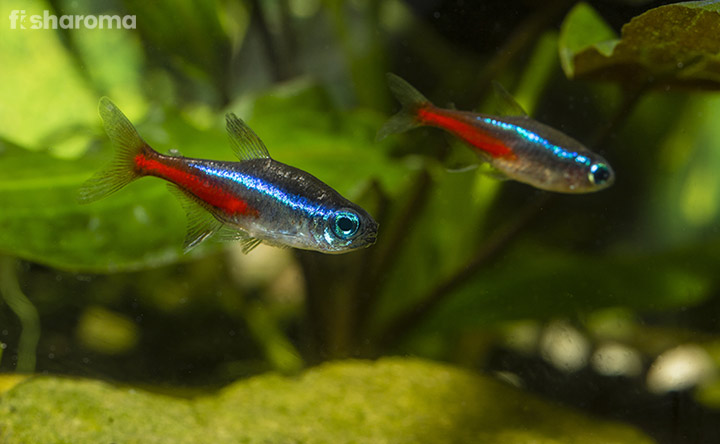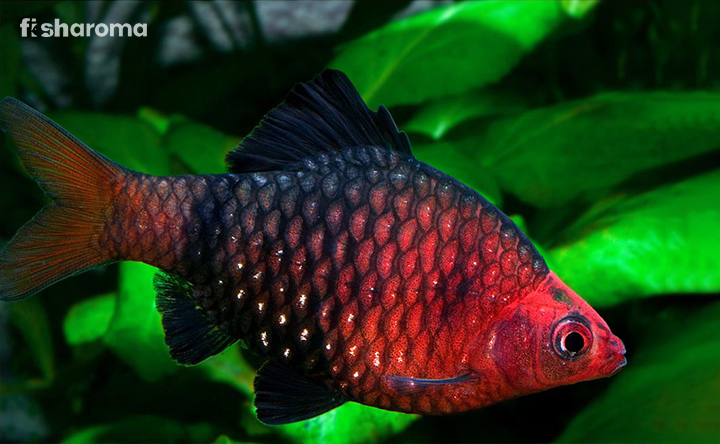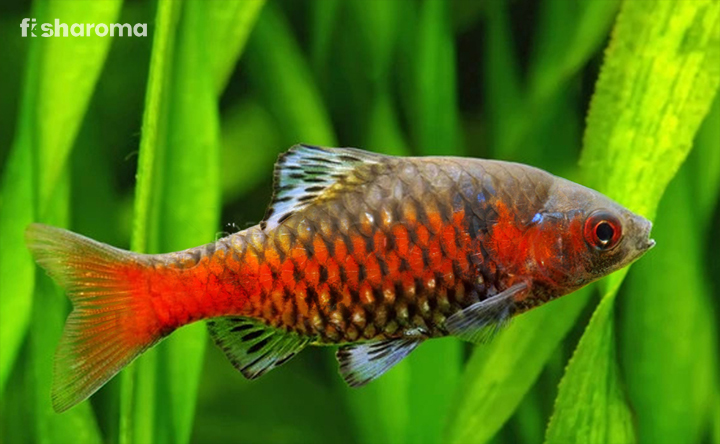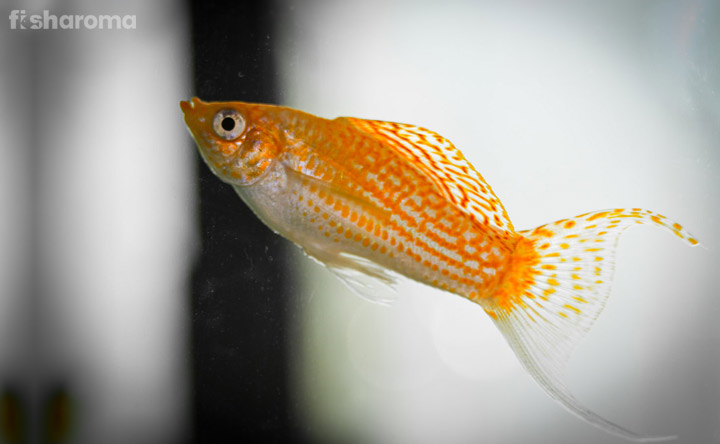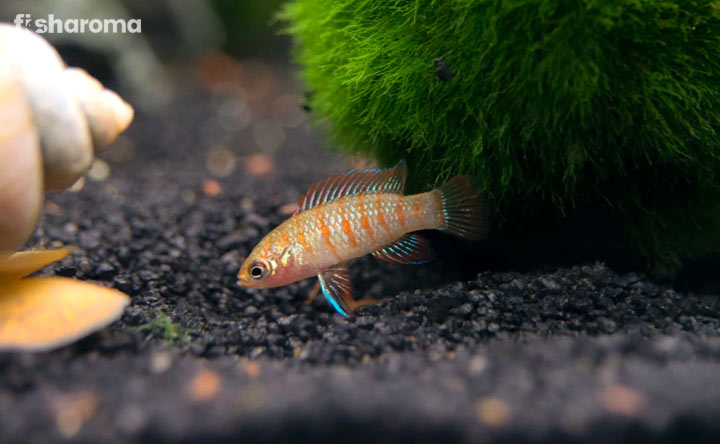Golden Wonder Killifish – A Care Guide To Malabar Killifish
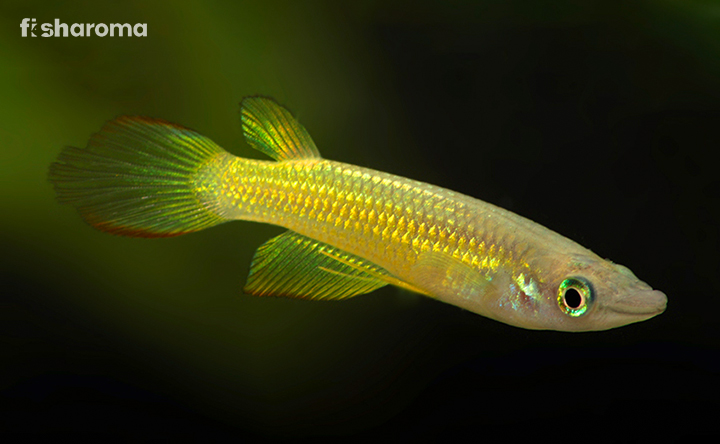
- Origin & Habitat of Golden Wonder Killifish
- Appearance of Golden Wonder Killifish
- Behaviour of Golden Wonder Killifish
- Lifespan of Golden Wonder Killifish
- Diet of Golden Wonder Killifish
- Tank Requirements for Golden Wonder Killifish
- Water Type for Golden Wonder Killifish
- Compatibility of Golden Wonder Killifish
- Breeding of Golden Wonder Killifish
- Diseases of Golden Wonder Killifish
- Summary
Striped Panchax, Malabar Killifish, Piki and the many names we know our Golden Wonder Killifish by, these beauties are unique. They look magnificent in the tank, so if you’re planning to add a little group of these graceful, glimmery fishes, you’re in the right place. In this complete care guide, we’re about to run you down all the important details you need to get your hands on, in the time of keeping. Keep reading to know more!
Key Specifications of Golden Wonder Killifish
Some quick information on these shiny fishes:
| Scientific Name | Aplocheilus lineatus |
| Origin | Sri Lanka, India. |
| Lifespan | 4-5 years |
| Colours/Patterns | Yellow, blue with orange stripes. |
| Temperament | Peaceful |
| Size | 1-2 inches |
| Diet | Omnivorous |
| Family | Aplocheilidae |
| Compatibility | Medium compatibility |
| Tank size | 20 gallons |
| Care level | Moderate |
| Water preference | Freshwater & Brackish Water |
| Breeding | Egg-layers |
Overview
Golden Wonder Killifish (Aplocheilus lineatus) is a fish species of immense beauty and splendour. These majestic beings mainly originate from parts of Asia like India and Sri Lanka. Their lifespan is pretty standard and their colouration is just mind-blowing. The more simple way to express them as species would be interesting fishes with shine! Let us proceed with the in-detail information, about our lovely Killifish species from the Aplocheilidae family.
Origin and Habitat of Golden Wonder Killifish
The Golden Wonder Killifish is native to the lands of Sri Lanka and India, which are basically waters of South and Southeast Asia.
Mostly found in the Asian paddy rice fields or paddies of other sorts. The Pikis are known for keeping insects off the fields, hence, they are used by the farmers for the very same purpose.
Appearance of Golden Wonder Killifish
The Malabar Killifish or the Golden Wonder Killifish have slight sexual dichromatism between the sexes. The males appear with more contrast and vibrancy in their colouration, whereas the females have a more calm and faded version of the same set of colours and hues.
Colour
These Killifishes have a yellowish-blue colouration as a base colour on their body, where you’ll notice spots and stripes of proper orange on top. The orange pattern majorly covers the fin region and is spread out to the rest of the body as well.
Size
These Killifishes are quite small, growing max about 4 inches, where the average size range is 1-2 inches in captivity. However, in the wild, there have been instances of these fishes reaching the size of 6 inches, which is just a standard freshwater fish if you properly analyze them.
Behaviour of Golden Wonder Killifish
Behaviour-wise, Golden Killifish are peaceful fishes in general. Still, you will notice some sort of aggression in male fishes, as they get territorial between themselves. If you just keep in mind some minimal rules, to maintain a proper community environment, Golden Wonder Killifishes are a great addition to your tank.
Make sure you keep them in a group of at least 4, but make the ratio even by having more females than males. There may be a certain level or clash or imbalance if the ratio is not properly maintained. They mostly swim on the surface layer of water, however, it is not a rare scenario for you to see them gently swimming in different water layers, like the bottom or middle. They can feed from any layer they usually swim in.
Lifespan of Golden Wonder Killifish
When the matter comes to the lifespan of Golden Wonder Killifish, they only live for about 5 years. The bottomline or average lifespan is 4 years, provided you take good care of the species and have a sharp look at the parameters and requirements.
Diet of Golden Wonder Killifish
These fishes are carnivorous, when it comes to their food preference. Make sure the food you provide them is high quality. These Killifish species are not the pickiest eaters out there, so in this department, you get to choose from a lot of possible options. Let’s help you take off the stress a little!
Some food options your cute fishes would love to munch on:
- Frozen fish food
- Freeze-dried fish food
- Fish flakes
- Fish pellets
- Tubiflex
- Bloodworms
- Daphnia
- Brine shrimp
Tank Requirements for Golden Wonder Killifish
Tank requirements are really important, especially when it comes to your lovely Golden Wonder Killifish. Let’s brief you up with their set of tank requirements you need to know about:
Tank Lid
Although, they are great jumpers which only poses more threats to their own lives. It’s confirmed for them to jump out, so it’s best to provide them with a tank lid to stop any kind of exposure to harm or an accident. Additionally, the lid can successfully prevent water pollution by stopping other harmful elements, like dust from getting accumulated and mixed in.
Tank Size
They need a tank size of at least 20 gallons. However, we recommend you to keep only about 4 fish at a time. If you’re increasing the numbers, make sure you increase the tank size accordingly.
Substrate
Your Killifishes look good in a nice dark substrate, as it showcases the unique and bright colouration of the fish. As they originally like paddy fields of rice or something similar, a soft, nice, fine layer of substrate rich in nutrients should work just fine.
Filter
Good filtration is a necessity for our Malabar Killifish. It oxygenates the water and circulates it well. Also, a good and strong filtration keeps the accumulation of waste in check.
Ornaments
Just like they are not very picky eaters, they aren’t that specific about decorations as well. Hence, focusing on what they like, it is best to emulate what they naturally like in the wild. Add some nice driftwood tangles, as it can work as a good secondary shelter option. Since they are territorial, the addition of proper hiding spaces is really appreciated by them. Rocky outcrops and nice caves for hiding are great options to incorporate in their tank as well.
Lighting
The lighting intensity should be low and subdued, as they mostly prefer to exist in shadows, when it comes to their natural habitat.
Presence of Flora
The Golden Wonder Killifish prefer a heavy layer of vegetation in the aquarium, naturally. Usage of several floating plants, stem-based or root based substrate plants work just perfectly. Plants, when present in an ample amount also work as great hiding spots, supporting their territorial nature and their love for hiding other than ornaments (more on this in the “ornaments” sub-section)
Cleaning Method
A proper cleaning method is of utmost importance, especially when it comes to the sanity, safety and your Killifish aquarium’s maintenance. It is likely that you will be facing some challenges and danger while dealing with your tank. So, if you don’t follow the proper methods to keep the tank in a clean and good condition, there will be consequences.
Monitor the parameters, and other conditions carefully and replace the tank water regularly (30% at least). Alternating the timings to clean your tank also works, as long as you do it religiously, considering the fish’s health in mind.
Otherwise, make sure you clean the tank walls with a cotton cloth. Do make use of proper filters and keep the tank aerated properly.
Water Type for Golden Wonder Killifish
Your aquarium’s overall ecosystem and health majorly depends upon how good you are at maintaining the parameters. If you don’t, it can hamper everything you’ve built with a good intention in just a nick of time.
Let’s have a look at the parameters:
| Hardness | 3-8 dKH, 5-12 dGH |
| Temperature | 22-28 Degrees Celsius |
| pH | 6.0-7.5 |
Hardness
The Golden Wonder Killifish like their water to be soft, so try to keep the carbonate hardness range around 3-8 dKH and general hardness range 5-12 dGH.
Temperature
The water temperature should be warm, so a temperature range of 22-28 Degrees Celsius works perfectly. In case the water range is not properly maintained naturally, use the best water heater so that the health of the fishes is not compromised.
pH
The Striped Panchax like acidity in their water, so a pH range of 6.0-7.5 should be good enough for these fishes.
Compatibility of Golden Wonder Killifish
It is not really tricky to pair our magnificent Golden Wonder Killifish, as they are generally peaceful. As long as you don’t cross their temperament by bothering with their territorial instincts, you’re totally fine to go.
Suitable Tank mates
Some suitable tank buddies for your Golden Wonder Killifish:
- Dwarf Cichlid(s)
- Large Tetra species (Diamond Tetra)
- Corydoras Catfish
- Otocinclus Catfish
- Banjo Catfish
- Rams (Bolivian Ram Cichlid)
- Vampire Shrimps
- Snails (Mystery Snail)
Unsuitable Tank mates
These Killies can also be a little predatory at times, hence they fall under the semi-aggressive category after showing both signs of peace and chaos simultaneously. Other than that, it is best to keep them away from other highly aggressive Cichlids or Betta fishes to prevent a poor tank environment overall.
Also, it is best to keep them with similar sized species, as they will either end up consuming the smaller and weaker, or get overwhelmed and consumed by superior species with a bad temper. Bigger, but friendly fishes still work but similar tank-temperament is an absolute no-no.
Breeding of Golden Wonder Killifish
Before we get started with the details of the breeding process for Golden Wonder Killifish, let’s talk a little about the ways they breed. They have three ways of possible spawning, namely non-annuals, semi-annuals and annuals.
- Non-annuals- These fishes live in permanent water bodies which never dry out annually or all-year wide.
- Semi-annuals- The Golden Wonders who fall under this category live in streams or rivers which dry out very occasionally. The process of drying out doesn’t have to be necessarily every year, it is more of a randomized process.
- Annuals- The Killifishes who fall under this category, usually reside in annual or yearly water bodies which are temporary. These pools usually dry up every year (precisely upto 6 months).
Introducing the Breedable pair
Prepare a separate breeding tank for the breed-able pair. Firstly, you will have to pick up a potential parent pair and isolate them to encourage the process. Since, they are sexually dichromatic and dimorphic, it is not that hard to tell apart between the male and female variants. Allow them to be introduced and exposed for the actual process to start.
Preparations
Turn up the water warmth a little to trigger the breeding process. Make sure your breeding tank also has soft water, with plenty of vegetal cover like floating plants and a bunch of leaves. A separate tank for the process of breeding ensures the security of the fries.
Breeding Process
The breeding specimens after completion of the process, should be separated. The parent fishes should be well-conditioned for quality fry and process success.
Hatching & After
After the parent Golden Wonder Killifish are done with the process, they lay their quite large eggs that get deposited on the floating plants. They lay about 100-150 eggs at a time (maximum reported amount of eggs laid is 250 eggs), so we recommend you to transfer the eggs immediately to yet another aquarium, specifically meant for the growth of the fries. The parent fishes don’t really possess that much of a parental instinct, so there’s no need to still keep them in the tank, after the eggs have popped out.
It takes about 14 days for the eggs to hatch, you will still see them having an egg sac attached to the underside of their body. The fry actually feed on that for some days, until they are ready to swim free. Provide enough protein rich bite-sized food to the fry, in order to keep them healthy and thriving. Baby Brine Shrimp or fry food powders act as a really good feedable options for the baby fishes.
Diseases of Golden Wonder Killifish
Their resilience and endurance towards most fatal diseases are commendable. Golden wonder Killifishes are quite hardy and adaptable as species, yet they are not invincible.
A few diseases that mostly affect this species:
- Marine Velvet- A disease affecting your precious Malabar Killifish, is caused by the parasite Oödinium, which is a dinoflagellate. The other name for this terrible disease is known as Gold Dust Illness.
Most bacterial infections get to this species of Killifish.
Treatment
Some ways of treatment and prevention are as below:
- Quarantine every element and properly prep them before you introduce that to your tank.
- Keep your community tank clean, in order to keep them free from bacteria.
- Isolate the diseased fish into a separate treatment tank, in order to avoid further spread of the disease to healthy fishes.
- Make use of anti-bacterial treatment in case of a bacterial infection.
- Introduce them to the best environment to avoid putting them in this situation in the first place.
Summary
All in all, Golden Wonder Killifish are extremely beautiful beings with a really glazy colouration. Their appearance is striking and they are not that hard to keep. Swimming about lightly in little schools look sweet in your aquarium. There’s no reason why you shouldn’t make them your brand new addition to the tank, so go for it!
Similar Care Guides you may like
- Peacock Gudgeon Care Guide: There is no denying that the vibrancy of this little fish is just out of this world. If you want to learn further about this fish species, check right here!
- Female Betta Fish Care Guide: Bettas, in general, are known for stealing the show in an aquarium with their flowy appearance and excellent colour contrasts. Have a look at this to know everything you need to!
- Peacock Eel Care Guide: Also known as the Spotfin Spiny Eel, what really stands out in their appearance is the beautiful eye-like patterns on their body. Want to know more about them and their care routine? Check this out.

